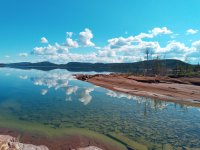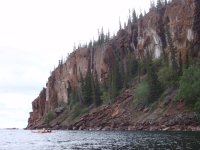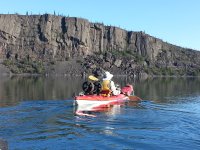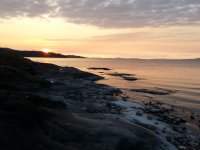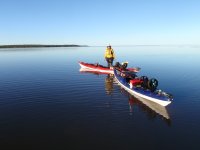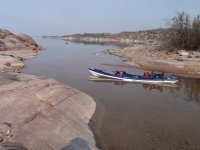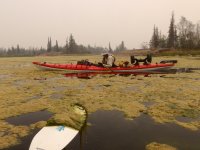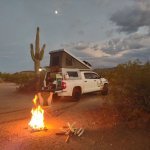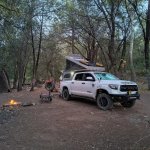Pacific Northwest yetti
Expedition Medic
Hi PNY
Thx for the nice comment.
Yes, we have a blog that is going to be receiving considerable attention from us once the dust clears from our trip. It is called "Paddle Strokes for Old Folks".
Funny you mentioned "field research". This trip had considerable aspects of research, all well hidden within a faulous trip. We were documenting the huge changes to the water level in the lake, same having gone from record highs a few years ago to unseen before low water this year. (https://www.cbc.ca/news/canada/nort...rritories-record-low-climate-change-1.6980937) This was to report on the new reality of recreational paddling on the 9th largest lake in the world after upwards of a 5 ft drop in water level.
We were also doing a bit of "seniors centric" experimenting on oursleves by doing an intense 80 or so day, hard wilderness expedition. We are strong believers that for a bunch of good reasons, older folks should and can (with some obvious adaptations..) still "get out there". Paddling flat water or modest rivers ensure no need to lug stuff around too much, thus saving backs, hips, knees, etc.
My partner is quite a well known BC artist and part of the trip was for gathering photos and sketches for a winter's work of creating a body of work depicting the amazing fauna and flora of the Great Slave Lake area.
Although my peak bagging/chasing first ascents days are ancient history, we were pretty sure that no one had ever paddled the entire circumference of GSLake in a single, uninterrupted trip so we thought, what the hell, as a secondary objective, why shouldn't we be the first? So the trip was planned for Hay River to Hay River, counterclockwise, leaving just after the ice had cleared in June.
PNY, you may appreciate this because of your profession....
Up until day 68, we were crushing the trip, sitting at 85% of the total distance (1332.2 km to be exact in the bag). On this day while waiting for the crazy winds to calm down, I was walking when I toppled over in the sand. It was weird but I got up and a couple of feet later, did it again. A self exam showed I had numbness and complete lack of dorsiflexion in my right ankle, this right out of the blue. I suspected at worst, a stroke or TIA. The winds were nuts but with InReach, I was able to get a helicopter to pluck us off the beach and fly to the hospital in Yellowknife, leaving all our gear on the beach. The great news was that I had damaged the Peroneal nerve in the leg (most likely from strain/overuse/positional abuse by sitting and bracing while operating the rudder pedals) so no brain injury but a wonky foot, hopefully only for the short term. The bad news is the trip had to be terminated. There was just no way of carrying on as my foot could not work the rudder in my boat and with fall winds and water picking up, controlling the loaded boats was demanding more and more effort. Recovery of the gear was also impossible as basically, no one would look at going into that stretch of water with either a boat or float plane.
The pictures below were taken just before we left. The little birch is holding it's own but thank goodness for 4 season tents!
Anyway PNY, that was a long answer to a short question! I will post some more stuff here on ExPo a little later.
I look forward to checking it out! I think its because I prefer field time, versus my job in the office. And miss the days (usually) when I was always in the field. But things change.
TIA, or Stroke would be unfortunate. However, the vast majority of the time, these will present with a neuro deficit as well. The Cincinnati pre hospital stroke scale, can easily be performed anywhere. And if you don’t already know it, could help put your mind at ease. As most things medical, its not definitive. And I suspect you know each other well enough to tell between normal/ no.
Well, the good news is that’s usually easily treatable with PT, and possibly inserts. As well as just an adaptation to the movement causing it. Even something like, take 1 day breaks every week, etc
Yall were making great time though! I 100% Agree, with the staying active thing.


